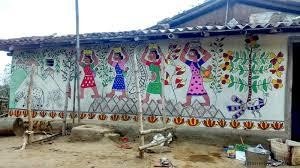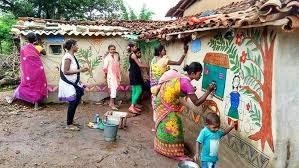Madhubani Murals On The Walls of These Jharkhand Village Homes Depict the Life and Times of Tribals
- The walls of houses in Jharkhand‟s Chandidih village are proud galleries displaying Madhubani masterpieces woven with everyday stories, thanks to Udbhav, a community art project.
- The tiny village of Chandidih in Khunti district, about 35 km from Ranchi, is a sight to behold. Home to community art project Udbhav, the whitewashed walls of the homes in the village are adorned with mesmerising pieces of Madhubani art.
- The paintings are the work of 20 art enthusiasts from the village and their young mentor Avinash Karn.
- Udbhav is unique in its execution in the sense that while depicting the traditional art form, the project also translates to art the life and times of the people in the village. Every piece of art, whether reproduced on paper or on the walls, holds a social message, born right out of the hearts of the villagers‟ life experiences.
- The unavailability of water, the need for collecting firewood, the lack of healthcare facilities, deforestation and local festivals of the community have made it to the murals. One of the strongest and most powerful messages is seen in the painting of the tribal women carrying water. The picture shows four women carrying water pots in their hands as well as on their heads, while their small children walk beside them.
- One of the women is shown to be pregnant, the child inside her belly painted powerfully by the local women to narrate their daily hardships.
- Avinash, who started the project in the village over a year ago in collaboration with Artreach India, observed the lives of the participants closely. He saw that women, no matter what the circumstances, were never able to take a break from their strenuous duties.
- “I saw that even when a woman was pregnant, she had to do all these things. I was shocked to see an eight months pregnant woman
- walking a few miles carrying water. Same was the case with women who had small children. Often women carry their newly born with them while they go to fetch water. The harsh reality needed to be addressed through the art. I was teaching them the technique, but moreover, I was helping them translate their own unique ideas to something tangible,” he says.
- An artist born to a family of Madhubani painters, Avinash had always strove to take the traditional art form away from repetition and imitation. He learned sculpting in Banaras Hindu University, which gave a certain depth and understanding of the third dimension to his paintings. Slowly, he developed a unique style of his own.
- Avinash conceived the idea of Udbhav in 2014, when he visited the village to conduct a week-long workshop. During his discussions with the local tribal participants, he realised that a skill like painting would help them become financially independent.
- He felt, however, that one single workshop wasn’t enough, and designed a year-long project that would allow them to excel in the artform.
- “I designed this project and was trying to get the required funding. However, I wasn‟t getting support. I was also criticised for imposing the Madhubani art form on the tribals. I wasn‟t able to comprehend how I was „imposing‟ when they themselves wanted to learn.
- Although Jharkhand has its traditional art form Sohrai, it isn‟t practiced in this part of the state. But we have also tried merging some techniques of Sohrai tradition with Madhubani. I believe art is art, and there‟s no need to put labels on it,” he says.
- In 2016, Avinash got the backing of Artreach India and the project kicked off. Avinash travels back and forth between Chandidih and Varanasi, where the freelance artist has a studio. He believes with the right training and exposure, all of his 20 students have the potential to make it as professional artists. Many have started working on assigned murals and some are even selling their work at different art galleries.
- Avinash recently conducted a workshop in the village, which was attended by local children. He has been trying to inculcate an artistic perspective and tries to encourage original ideas and imageries at his workshops.
- “I have always been fascinated by the idea of earth meeting the sky in the far off distance. When I told that to Avinash Bhaiyya, he asked me paint how would I like to see the earth meeting the sky. So I painted a view that I‟d be able to see from the top of Qutub Minar, the tallest of all towers,” says 13-year-old Nikita Tappo, a participant of the Udbhav workshop.
- The community art project has interested not only the villagers, but many outsiders as well. The murals on the village walls often attract a curious eye, which has led to many of the artists getting work from outside the village. Sadly, the rain has washed away the murals on mud walls, but the ones on cement walls still stand as the representation of the collective art consciousness of the community.


